The Influence of Cu on the Aging Mechanical Properties and Precipitate Behavior of Si-Rich Al-Mg-Si Alloy
Abstract
1. Introduction
2. Materials and Methods
3. Results and Discussion
3.1. Age-Hardening Behavior
3.2. Tensile Properties
3.3. TEM Bright-Field Images Aged at 155 °C
3.3.1. TEM Bright-Field Images of Under-Aged Alloys (Aged at 155 °C for 2 h)
3.3.2. TEM Bright-Field Images of Peak-Aged Alloys (Aged at 155 °C for 10 h)
3.3.3. TEM Bright-Field Images of Over-Aged Alloys (Aged at 155 °C for 24 h)
3.4. TEM Images of Heavily Over-Aged Alloys (Aged at 185 °C for 24 h)
4. Conclusions
- The Cu-added alloy exhibits higher hardness than the Cu-free alloy across various aging temperatures and demonstrates a more rapid age-hardening response during the under-aged stage. The time required for both alloys to reach peak hardness decreases with increasing aging temperature, with the most significant age-hardening effect observed at 155 °C.
- The relatively rapid age-hardening response observed in the under-aged condition of Cu-added alloys can be attributed to the accelerated clustering kinetics induced by Cu during the early stages of aging, which increases the number density of precipitate phases.
- Cu promotes the formation of the peak-aged β″ phase, refines the precipitate size, and induces the co-precipitation of a minor quantity of lath-shaped phases. It also promotes the precipitation of Cu-containing Q-phase at the grain boundary in peak-aged alloys and reduces the width of PFZs. Cu-added alloys exhibit superior mechanical properties in the peak-aged state, with a tensile strength of approximately 387 MPa and an elongation of ~19%, compared to 355 MPa and 15% for Cu-free alloy.
- Cu significantly reduces the softening rate of the alloy during the over-aging process. In the Cu-free alloy, the heavily over-aged microstructure is predominantly composed of rod-shaped β′ phases, with a minor presence of U2 phases. The Cu-added alloy exhibited a substantial amount of lath-shaped precipitates (predominantly the L phase) during the over-aging process. These lath-shaped precipitates exhibited significantly higher thermal stability compared to the β′ phase, thereby improving the mechanical properties of the alloy under heavily over-aged conditions.
Author Contributions
Funding
Data Availability Statement
Conflicts of Interest
References
- Zang, R.; Ding, L.; Ehlers, F.J.H.; Jia, Z.; Xu, S.; Li, Y.; Cao, L. The Influence of Cu Content and Mg/Si Ratio on the Strength and Formability in Al-Mg-Si-Cu Alloys. Mater. Charact. 2023, 205, 113355. [Google Scholar] [CrossRef]
- Du, J.; Guo, M.; Zhi, J.; Chen, X.; Zhuang, L.; Kestens, L.A.I. Coordinated Deformation Mechanisms of High Formability Al–Mg–Si–Cu–Zn–Fe Alloys via Coupling Control of Thermomechanical Processes. Mater. Chem. Phys. 2024, 320, 129471. [Google Scholar] [CrossRef]
- Chen, Y.; Wei, W.; Zhao, Y.; Shi, W.; Zhou, X.; Rong, L.; Wen, S.; Wu, X.; Gao, K.; Huang, H.; et al. Effect of the Solid Solution and Aging Treatment on the Mechanical Properties and Microstructure of a Novel Al-Mg-Si Alloy. Materials 2023, 16, 7036. [Google Scholar] [CrossRef]
- Zhu, L.; Li, K.; Yang, X.; He, J.; Fang, J.; Zhang, Z.; Guo, M.; Zhang, J. Tailoring the Formability and Planar Anisotropy of Al-Mg-Si-Cu-Zn Alloys via Cross Hot Rolling and Two-Stage Cold Rolling. J. Alloys Compd. 2024, 985, 174089. [Google Scholar] [CrossRef]
- Hong, H.-B.; Hajra, R.N.; Shin, E.; Kim, J.-K.; Lee, J.-S.; Kim, J.H.; Kim, J.; Cho, H.-H. Effect of Heat Treatment and Cu Addition on the Mechanical, Electrochemical, and Precipitation Behavior of Al–Mg–Si Alloys. J. Mater. Res. Technol. 2025, 36, 1822–1834. [Google Scholar] [CrossRef]
- Edwards, G.A.; Stiller, K.; Dunlop, G.L.; Couper, M.J. The Precipitation Sequence in Al–Mg–Si Alloys. Acta Mater. 1998, 46, 3893–3904. [Google Scholar] [CrossRef]
- Murayama, M.; Hono, K. Pre-Precipitate Clusters and Precipitation Processes in Al–Mg–Si Alloys. Acta Mater. 1999, 47, 1537–1548. [Google Scholar] [CrossRef]
- Frøseth, A.G.; Høier, R.; Derlet, P.M.; Andersen, S.J.; Marioara, C.D. Bonding in MgSi and Al-Mg-Si Compounds Relevant to Al-Mg-Si Alloys. Phys. Rev. B 2003, 67, 224106. [Google Scholar] [CrossRef]
- Andersen, S.J.; Marioara, C.D.; Frøseth, A.; Vissers, R.; Zandbergen, H.W. Crystal Structure of the Orthorhombic U2-Al4Mg4Si4 Precipitate in the Al–Mg–Si Alloy System and Its Relation to the Β′ and Β″ Phases. Mater. Sci. Eng. A 2005, 390, 127–138. [Google Scholar] [CrossRef]
- Andersen, S.J.; Marioara, C.D.; Vissers, R.; Frøseth, A.; Zandbergen, H.W. The Structural Relation between Precipitates in Al–Mg–Si Alloys, the Al-Matrix and Diamond Silicon, with Emphasis on the Trigonal Phase U1-MgAl2Si2. Mater. Sci. Eng. A 2007, 444, 157–169. [Google Scholar] [CrossRef]
- Wu, X.; Liu, X.; Wang, X.; Ma, P.-K.; Guan, Z.-P. Effect of Cu and Sn Additions on the Thermal Stability of Al–Mg–Si Alloy. Mater. Sci. Eng. A 2024, 894, 146158. [Google Scholar] [CrossRef]
- Saito, T.; Mørtsell, E.A.; Wenner, S.; Marioara, C.D.; Andersen, S.J.; Friis, J.; Matsuda, K.; Holmestad, R. Atomic Structures of Precipitates in Al–Mg–Si Alloys with Small Additions of Other Elements. Adv. Eng. Mater. 2018, 20, 1800125. [Google Scholar] [CrossRef]
- Marioara, C.D.; Andersen, S.J.; Stene, T.N.; Hasting, H.; Walmsley, J.; Van Helvoort, A.T.J.; Holmestad, R. The Effect of Cu on Precipitation in Al–Mg–Si Alloys. Philos. Mag. 2007, 87, 3385–3413. [Google Scholar] [CrossRef]
- Torsæter, M.; Lefebvre, W.; Marioara, C.D.; Andersen, S.J.; Walmsley, J.C.; Holmestad, R. Study of Intergrown L and Q′ Precipitates in Al–Mg–Si–Cu Alloys. Scr. Mater. 2011, 64, 817–820. [Google Scholar] [CrossRef]
- Weng, Y.; Ding, L.; Jia, Z.; Liu, Q. Effect of Combined Addition of Ag and Cu on the Precipitation Behavior for an Al-Mg-Si Alloy. Mater. Charact. 2021, 171, 110736. [Google Scholar] [CrossRef]
- Kawahara, Y.; Marioara, C.D.; Hell, C.M.; Thrane, E.S.; Mørtsell, E.A.; Røyset, J.; Holmestad, R.; Kaneko, K. Effect of Cu Addition on Atomic Clusters and Its Influence on the Dispersion of Precipitates in Si-Rich Al-Mg-Si Alloys. Mater. Sci. Eng. A 2025, 946, 149121. [Google Scholar] [CrossRef]
- Liu, T.; Scholtz, J.; Xue, F.; Yung, A.; Guiglionda, G.; Marquis, E.A. Effects of Cu and Pre-Aging on the Clustering Behavior in Al-Mg-Si Alloys. Materialia 2023, 32, 101917. [Google Scholar] [CrossRef]
- Zandbergen, H.W.; Andersen, S.J.; Jansen, J. Structure Determination of Mg5 Si6 Particles in Al by Dynamic Electron Diffraction Studies. Science 1997, 277, 1221–1225. [Google Scholar] [CrossRef]
- Liu, Y.; Lai, Y.X.; Chen, Z.Q.; Chen, S.L.; Gao, P.; Chen, J.H. Formation of β"-Related Composite Precipitates in Relation to Enhanced Thermal Stability of Sc-Alloyed Al-Mg-Si Alloys. J. Alloys Compd. 2021, 885, 160942. [Google Scholar] [CrossRef]
- Buchanan, K.; Colas, K.; Ribis, J.; Lopez, A.; Garnier, J. Analysis of the Metastable Precipitates in Peak-Hardness Aged Al-Mg-Si(-Cu) Alloys with Differing Si Contents. Acta Mater. 2017, 132, 209–221. [Google Scholar] [CrossRef]
- Gupta, A.K.; Lloyd, D.J.; Court, S.A. Precipitation Hardening in Al–Mg–Si Alloys with and without Excess Si. Mater. Sci. Eng. A 2001, 316, 11–17. [Google Scholar] [CrossRef]
- Zhong, H.; Rometsch, P.A.; Estrin, Y. The Influence of Si and Mg Content on the Microstructure, Tensile Ductility, and Stretch Formability of 6xxx Alloys. Metall. Mater. Trans. A 2013, 44, 3970–3983. [Google Scholar] [CrossRef]
- Zhu, L.; Guo, M.; Zhang, J. Effect of Silicon Content on Nucleation and Growth of Multiscale Precipitates in Al–Mg–Si–Cu–Zn Alloys for Different Aging Paths. Mater. Sci. Eng. A 2022, 841, 143016. [Google Scholar] [CrossRef]
- GB/T 228.1-2010; Metallic Materials—Tensile Testing—Part 1: Method of Test at Room Temperature. Standards Press of China: Beijing, China, 2010.
- Buha, J.; Lumley, R.N.; Crosky, A.G.; Hono, K. Secondary Precipitation in an Al–Mg–Si–Cu Alloy. Acta Mater. 2007, 55, 3015–3024. [Google Scholar] [CrossRef]
- Li, H.; Zhao, P.; Wang, Z.; Mao, Q.; Fang, B.; Song, R.; Zheng, Z. The Intergranular Corrosion Susceptibility of a Heavily Overaged Al-Mg-Si-Cu Alloy. Corros. Sci. 2016, 107, 113–122. [Google Scholar] [CrossRef]
- Jacobs, M.H. The Structure of the Metastable Precipitates Formed during Ageing of an Al-Mg-Si Alloy. Philos. Mag. 1972, 26, 1–13. [Google Scholar] [CrossRef]
- Yang, W.; Wang, M.; Zhang, R.; Zhang, Q.; Sheng, X. The Diffraction Patterns from Β″ Precipitates in 12 Orientations in Al–Mg–Si Alloy. Scr. Mater. 2010, 62, 705–708. [Google Scholar] [CrossRef]
- Andersen, S.J.; Zandbergen, H.W.; Jansen, J.; Tr, C.; Tundal, U.; Reiso, O. The Crystal Structure of the β″ Phase in Al-Mg-Si Alloys. Acta Mater. 1998, 46, 3283–3298. [Google Scholar] [CrossRef]
- Esmaeili, S.; Wang, X.; Lloyd, D.J.; Poole, W.J. On the Precipitation-Hardening Behavior of the Al-Mg-Si-Cu Alloy AA6111. Metall. Mater. Trans. A 2003, 34, 751–763. [Google Scholar]
- Li, K.; Béché, A.; Song, M.; Sha, G.; Lu, X.; Zhang, K.; Du, Y.; Ringer, S.P.; Schryvers, D. Atomistic Structure of Cu-Containing Β″ Precipitates in an Al–Mg–Si–Cu Alloy. Scr. Mater. 2014, 75, 86–89. [Google Scholar] [CrossRef]
- Frodal, B.H.; Christiansen, E.; Myhr, O.R.; Hopperstad, O.S. The Role of Quench Rate on the Plastic Flow and Fracture of Three Aluminium Alloys with Different Grain Structure and Texture. Int. J. Eng. Sci. 2020, 150, 103257. [Google Scholar] [CrossRef]
- Poole, W.J.; Wang, X.; Embury, J.D.; Lloyd, D.J. The Effect of Manganese on the Microstructure and Tensile Response of an Al-Mg-Si Alloy. Mater. Sci. Eng. A 2019, 755, 307–317. [Google Scholar] [CrossRef]
- Arani, M.M.; Ramesh, N.S.; Wang, X.; Parson, N.; Li, M.; Poole, W.J. The Localization of Plastic Deformation in the Precipitate Free Zone of an Al-Mg-Si-Mn Alloy. Acta Mater. 2022, 231, 117872. [Google Scholar] [CrossRef]
- Bartawi, E.H.; Shaban, G.; Ambat, R. Role of Aging Time and Cu/Zn Additions on the Microstructure and Intergranular Corrosion Resistance of 6082 Al-Mg-Si Alloy. Corros. Sci. 2025, 254, 113027. [Google Scholar] [CrossRef]
- Svenningsen, G.; Larsen, M.H.; Walmsley, J.C.; Nordlien, J.H.; Nisancioglu, K. Effect of Artificial Aging on Intergranular Corrosion of Extruded AlMgSi Alloy with Small Cu Content. Corros. Sci. 2006, 48, 1528–1543. [Google Scholar] [CrossRef]
- Bartawi, E.H.; Mishin, O.V.; Shaban, G.; Nordlien, J.H.; Ambat, R. Electron Microscopy Analysis of Grain Boundaries and Intergranular Corrosion in Aged Al-Mg-Si Alloy Doped with 0.05 Wt% Cu. Corros. Sci. 2022, 209, 110758. [Google Scholar] [CrossRef]
- Svenningsen, G.; Lein, J.E.; Bjørgum, A.; Nordlien, J.H.; Yu, Y.; Nisancioglu, K. Effect of Low Copper Content and Heat Treatment on Intergranular Corrosion of Model AlMgSi Alloys. Corros. Sci. 2006, 48, 226–242. [Google Scholar] [CrossRef]
- Vissers, R.; Van Huis, M.A.; Jansen, J.; Zandbergen, H.W.; Marioara, C.D.; Andersen, S.J. The Crystal Structure of the β′ Phase in Al–Mg–Si Alloys. Acta Mater. 2007, 55, 3815–3823. [Google Scholar] [CrossRef]
- Miao, W.F.; Laughlin, D.E. Effects of Cu Content and Preaging on Precipitation Characteristics in Aluminum Alloy 6022. Metall. Mater. Trans. A 2000, 31, 361–371. [Google Scholar] [CrossRef]
- Marioara, C.D.; Andersen, S.J.; Røyset, J.; Reiso, O.; Gulbrandsen-Dahl, S.; Nicolaisen, T.-E.; Opheim, I.-E.; Helgaker, J.F.; Holmestad, R. Improving Thermal Stability in Cu-Containing Al-Mg-Si Alloys by Precipitate Optimization. Metall. Mater. Trans. A 2014, 45, 2938–2949. [Google Scholar] [CrossRef]
- Matsuda, K.; Sakaguchi, Y.; Miyata, Y.; Uetani, Y.; Sato, T.; Kamio, A.; Ikeno, S. Precipitation Sequence of Various Kinds of Metastable Phases in Al-1.0mass% Mg2Si-0.4mass% Si Alloy. J. Mater. Sci. 2000, 35, 179–189. [Google Scholar] [CrossRef]
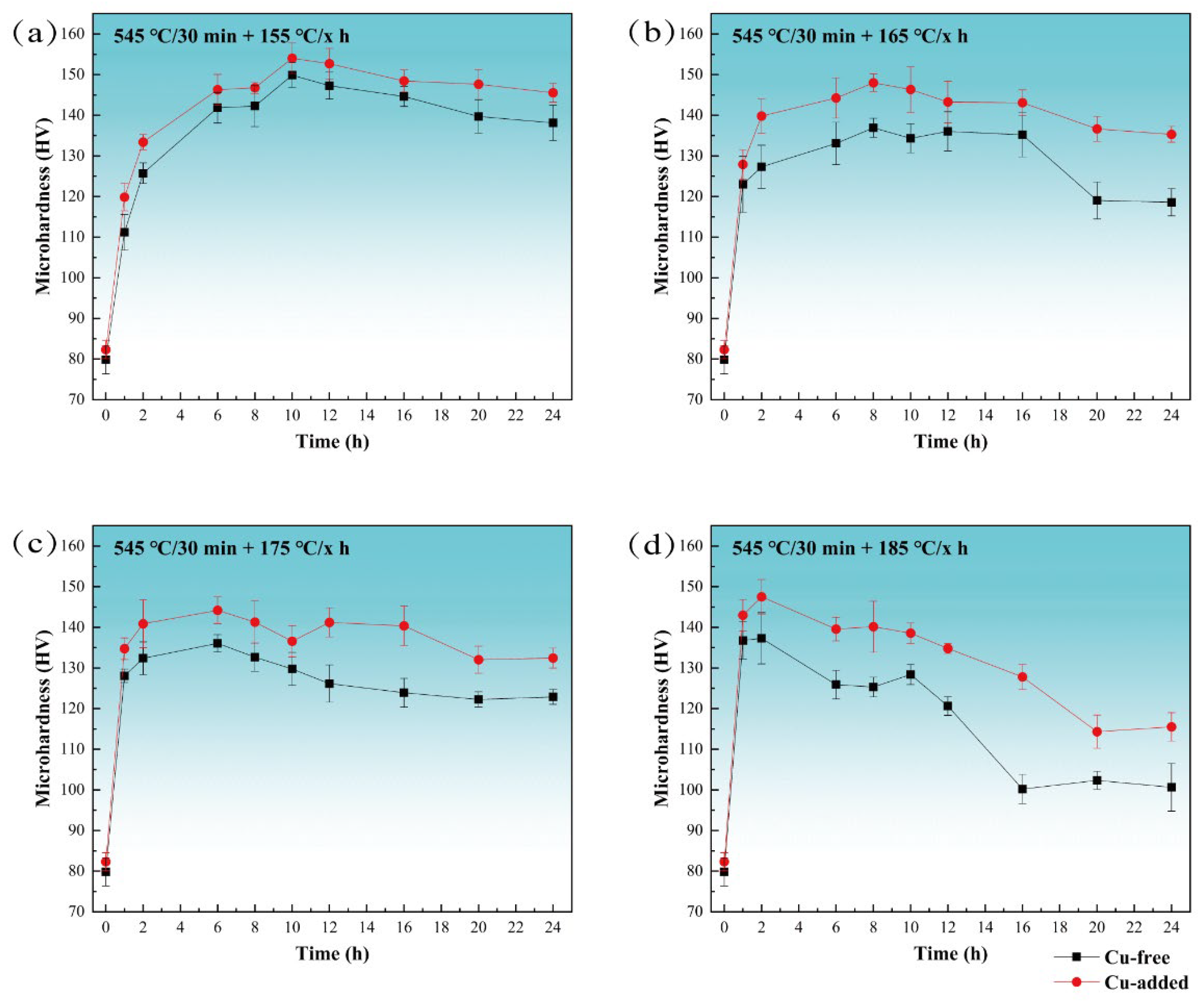


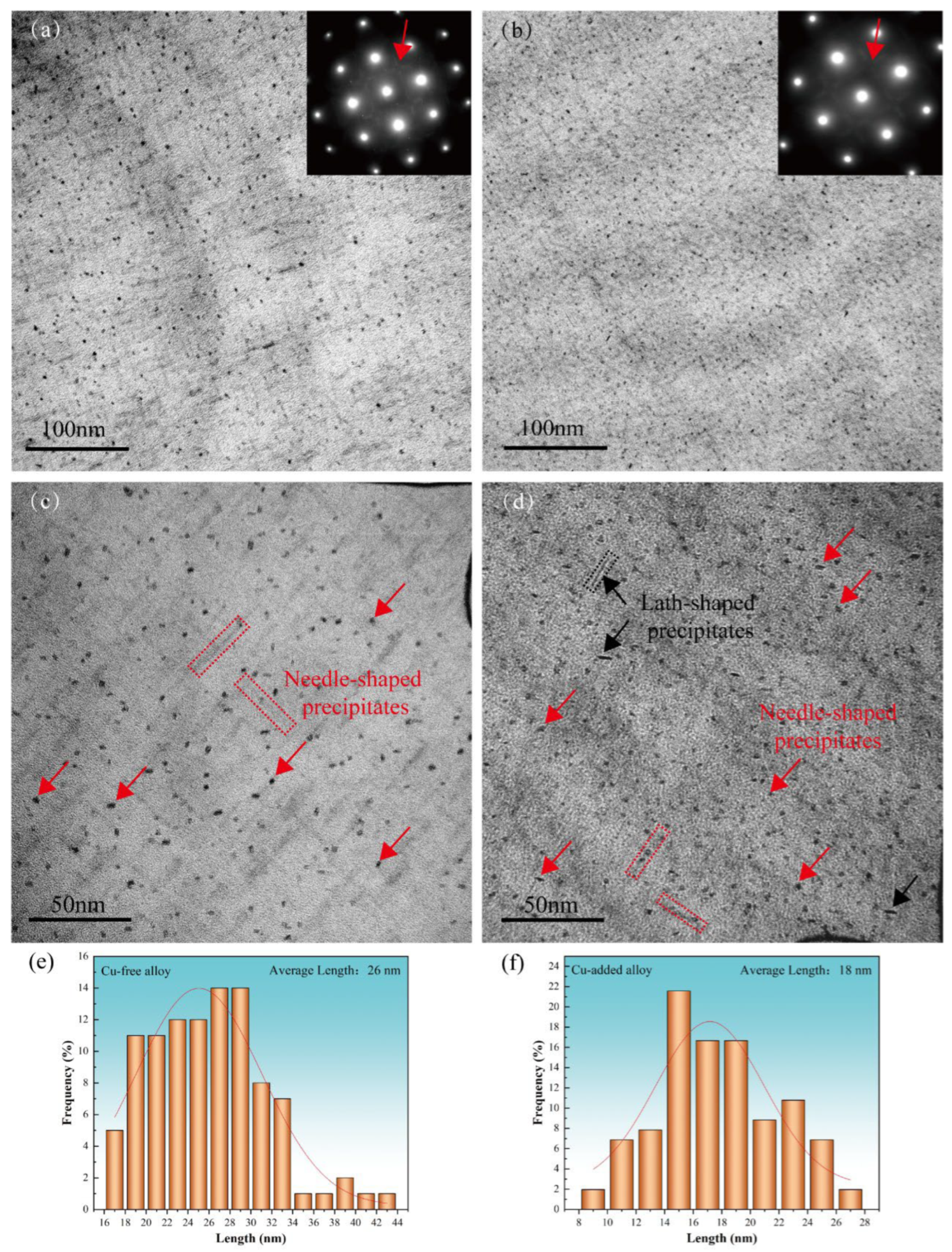
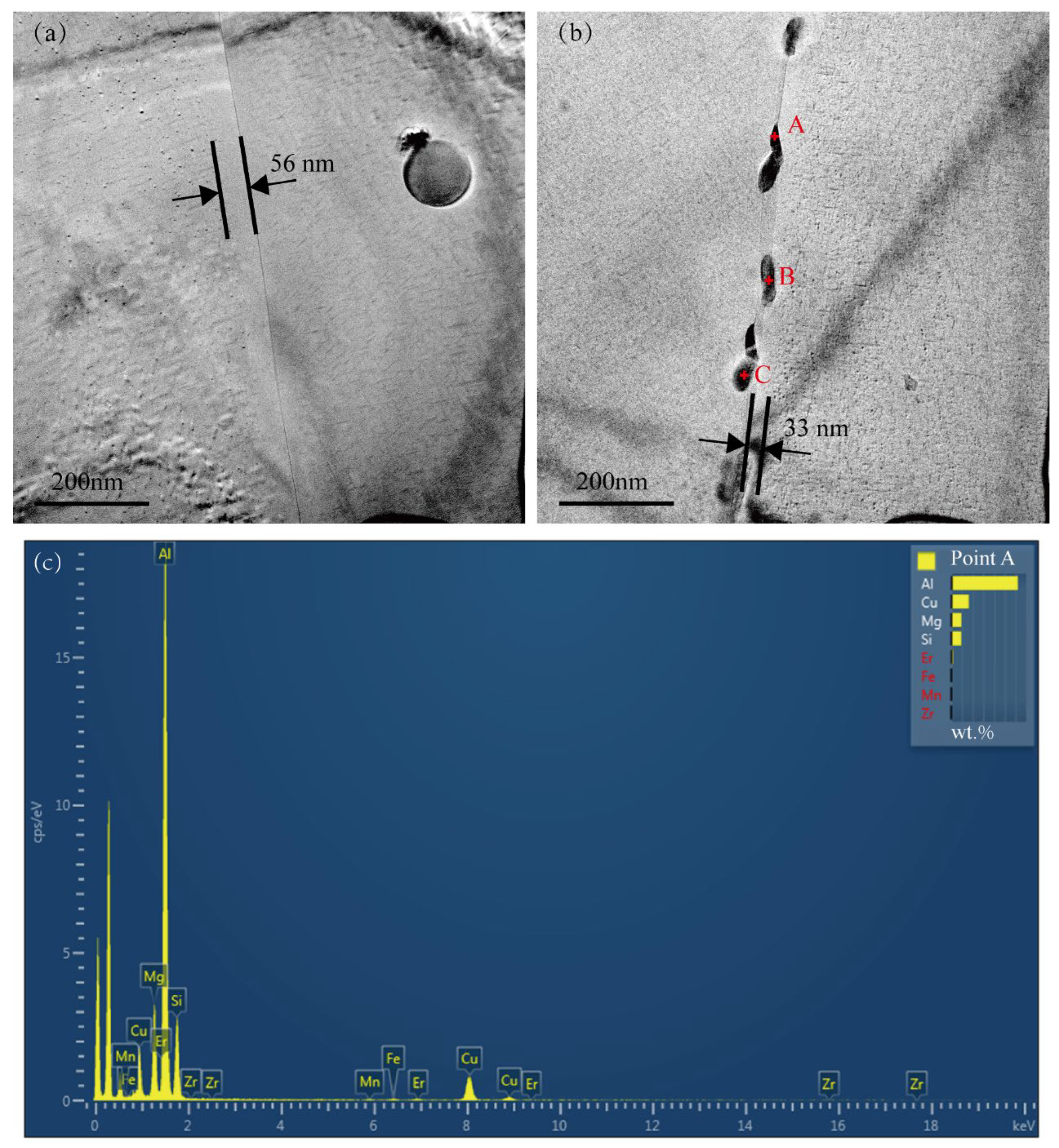
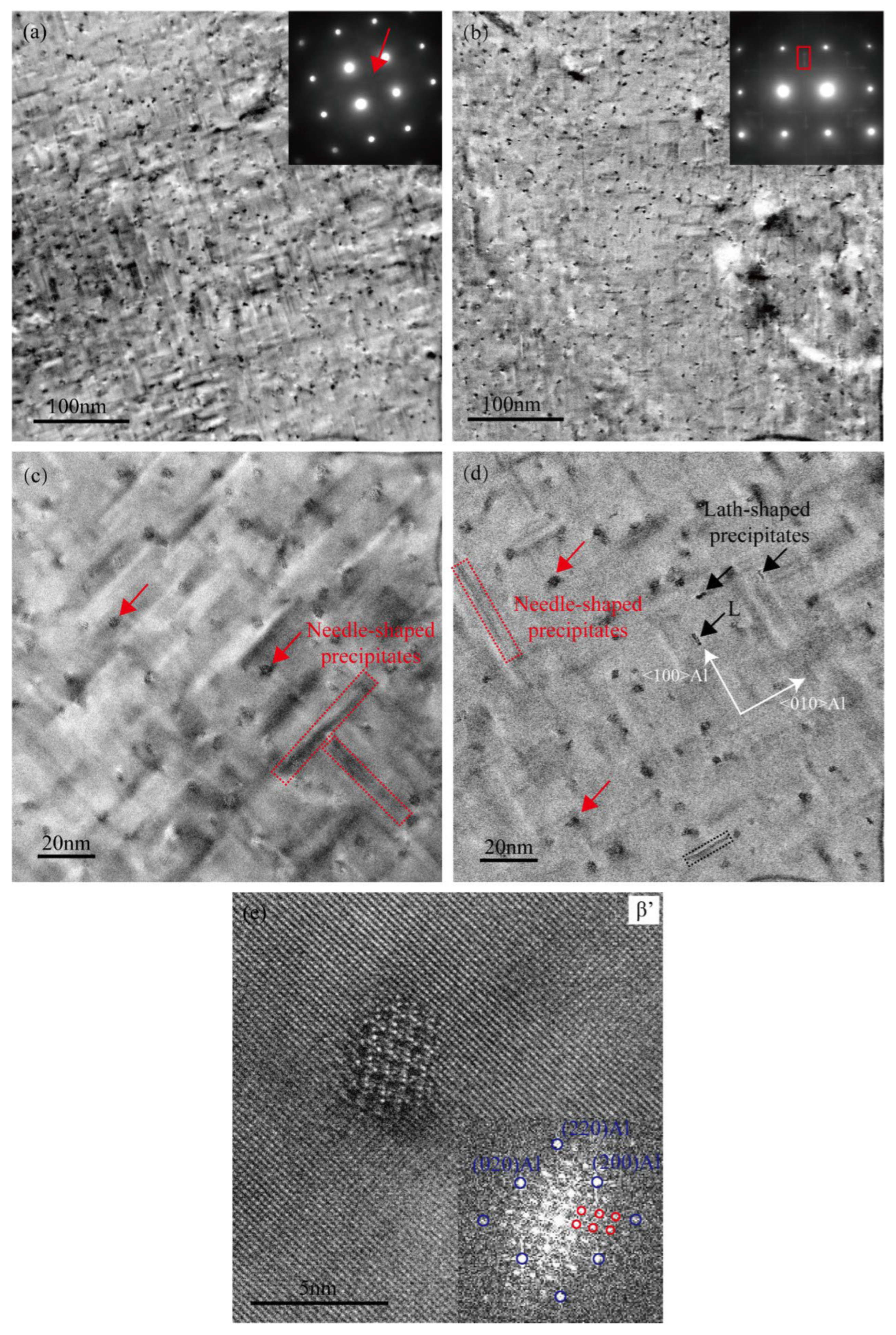
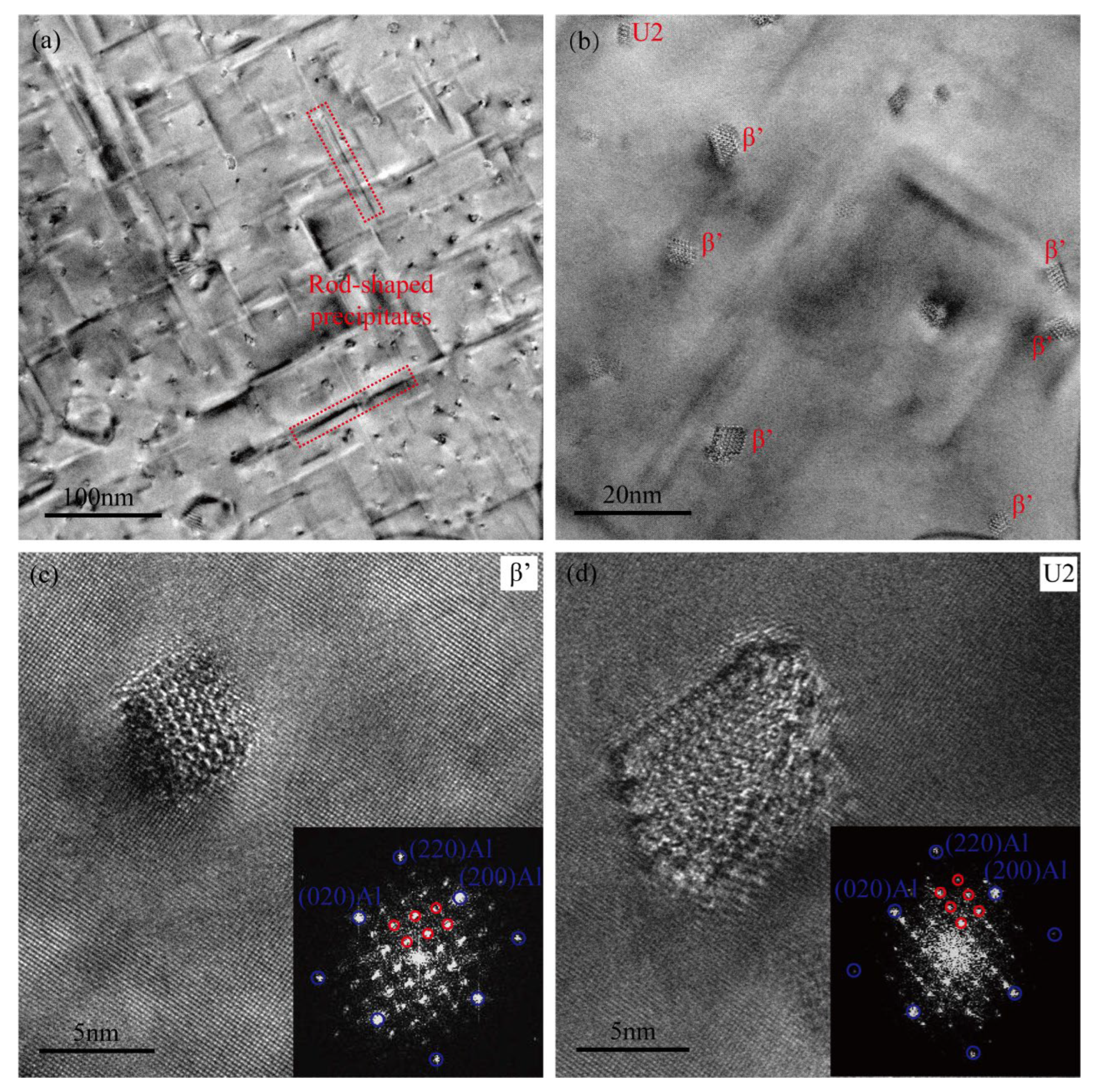

| Alloy | Mg | Si | Cu | Mn | Er | Zr | Al |
|---|---|---|---|---|---|---|---|
| Cu-free | 0.88 | 1.48 | - | 0.36 | 0.14 | 0.13 | Balance |
| Cu-added | 0.88 | 1.44 | 0.36 | 0.37 | 0.11 | 0.12 | Balance |
| Point | Al | Mg | Si | Cu |
|---|---|---|---|---|
| A | 62.2 | 9.4 | 9.3 | 16.5 |
| B | 70.5 | 5.0 | 9.3 | 12 |
| C | 68.5 | 5.4 | 10.0 | 13.8 |
Disclaimer/Publisher’s Note: The statements, opinions and data contained in all publications are solely those of the individual author(s) and contributor(s) and not of MDPI and/or the editor(s). MDPI and/or the editor(s) disclaim responsibility for any injury to people or property resulting from any ideas, methods, instructions or products referred to in the content. |
© 2025 by the authors. Licensee MDPI, Basel, Switzerland. This article is an open access article distributed under the terms and conditions of the Creative Commons Attribution (CC BY) license (https://creativecommons.org/licenses/by/4.0/).
Share and Cite
Zhao, Y.; Wei, W.; Lu, Y.; Rong, Z.; Wen, S.; Huang, H.; Nie, Z. The Influence of Cu on the Aging Mechanical Properties and Precipitate Behavior of Si-Rich Al-Mg-Si Alloy. Metals 2025, 15, 1171. https://doi.org/10.3390/met15111171
Zhao Y, Wei W, Lu Y, Rong Z, Wen S, Huang H, Nie Z. The Influence of Cu on the Aging Mechanical Properties and Precipitate Behavior of Si-Rich Al-Mg-Si Alloy. Metals. 2025; 15(11):1171. https://doi.org/10.3390/met15111171
Chicago/Turabian StyleZhao, Yu, Wu Wei, Yi Lu, Zhizheng Rong, Shengping Wen, Hui Huang, and Zuoren Nie. 2025. "The Influence of Cu on the Aging Mechanical Properties and Precipitate Behavior of Si-Rich Al-Mg-Si Alloy" Metals 15, no. 11: 1171. https://doi.org/10.3390/met15111171
APA StyleZhao, Y., Wei, W., Lu, Y., Rong, Z., Wen, S., Huang, H., & Nie, Z. (2025). The Influence of Cu on the Aging Mechanical Properties and Precipitate Behavior of Si-Rich Al-Mg-Si Alloy. Metals, 15(11), 1171. https://doi.org/10.3390/met15111171







